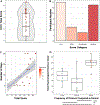Psychological distress in the face of a pandemic: An observational study characterizing the impact of COVID-19 on immigrant outpatient mental health
- PMID: 33296817
- PMCID: PMC7805919
- DOI: 10.1016/j.psychres.2020.113595
Psychological distress in the face of a pandemic: An observational study characterizing the impact of COVID-19 on immigrant outpatient mental health
Abstract
Undocumented immigrants have disproportionately suffered during the novel coronavirus disease 2019 (COVID-19) pandemic due to factors including limited medical access and financial insecurity, which can exacerbate pandemic-associated distress. Psychological outcomes for immigrant outpatients were assessed after transition to telepsychiatry in March 2020. Mental health was assessed with Patient Health Questionnaire (PHQ-2) and Generalized Anxiety Disorder (GAD-2) inventories, a novel coronavirus-specific survey, and the Kessler Psychological Distress Scale (K10+). Feedback on telepsychiatry sessions and access to non-clinical resources were also gathered, after which multivariable linear regression modeling identified psychosocial factors underlying changes in distress levels. 48.57% and 45.71% of participants reported worsened anxiety and depression levels due to the pandemic, respectively. From March to April, PHQ-2 and GAD-2 scores significantly increased by 0.81 and 0.63 points, respectively. The average total psychological distress score was 23.8, with 60% of scores reflecting serious mental illness. Factors that most influenced K10+ scores included a pre-existing depressive disorder, food insecurity, and comfort during telepsychiatry visits. 93.75% of participants believed access to remote psychiatry helped their mental health during COVID-19. The negative impact of COVID-19 on mental health in vulnerable populations stems from medical and psychosocial factors such as pre-existing psychiatric conditions and unmet essential needs.
Keywords: Anxiety; COVID-19; Depression; Distress; Mental health; Telepsychiatry; Vulnerable populations.
Copyright © 2020. Published by Elsevier B.V.
Conflict of interest statement
Conflicts of Interest
The authors have no conflicts to report.
Figures



Similar articles
-
Assessing the impact of COVID-19 on outpatient psychiatric population well-being and symptomology utilizing COVID-19 Events Checklist (CEC) and Measurement Based Care.J Patient Rep Outcomes. 2024 Nov 21;8(1):135. doi: 10.1186/s41687-024-00802-z. J Patient Rep Outcomes. 2024. PMID: 39570497 Free PMC article.
-
Estimation of Psychological Impairment and Coping Strategies during COVID-19 Pandemic among University Students in Saudi Arabia: A Large Regional Analysis.Int J Environ Res Public Health. 2022 Nov 1;19(21):14282. doi: 10.3390/ijerph192114282. Int J Environ Res Public Health. 2022. PMID: 36361173 Free PMC article.
-
Younger people are more vulnerable to stress, anxiety and depression during COVID-19 pandemic: A global cross-sectional survey.Prog Neuropsychopharmacol Biol Psychiatry. 2021 Jul 13;109:110236. doi: 10.1016/j.pnpbp.2020.110236. Epub 2020 Dec 26. Prog Neuropsychopharmacol Biol Psychiatry. 2021. PMID: 33373680 Free PMC article.
-
Prevalence of anxiety, depression, and psychological distress among the general population during the COVID-19 pandemic: A systematic review and meta-analysis.Int J Soc Psychiatry. 2021 Nov;67(7):892-906. doi: 10.1177/00207640211003121. Epub 2021 Apr 1. Int J Soc Psychiatry. 2021. PMID: 33794717
-
Impact of COVID-19 pandemic on mental health in the general population: A systematic review.J Affect Disord. 2020 Dec 1;277:55-64. doi: 10.1016/j.jad.2020.08.001. Epub 2020 Aug 8. J Affect Disord. 2020. PMID: 32799105 Free PMC article.
Cited by
-
A review of mental health disparities during COVID-19: Evidence, mechanisms, and policy recommendations for promoting societal resilience.Dev Psychopathol. 2023 Oct;35(4):1821-1842. doi: 10.1017/S0954579422000499. Epub 2022 Sep 13. Dev Psychopathol. 2023. PMID: 36097815 Free PMC article. Review.
-
Risk factors of psychological distress during the COVID-19 pandemic: The roles of coping style and emotional regulation.J Affect Disord. 2022 Feb 15;299:326-334. doi: 10.1016/j.jad.2021.12.026. Epub 2021 Dec 14. J Affect Disord. 2022. PMID: 34920036 Free PMC article.
-
COVID-19 pandemic and mental health among Hispanic/Latino/a immigrants in the USA: protocol for a scoping review.BMJ Open. 2023 Dec 12;13(12):e073687. doi: 10.1136/bmjopen-2023-073687. BMJ Open. 2023. PMID: 38086590 Free PMC article.
-
Racial/Ethnic and Nativity Disparities in Gestational Diabetes Mellitus, United States 2018-2021.J Racial Ethn Health Disparities. 2025 Mar 13. doi: 10.1007/s40615-025-02376-y. Online ahead of print. J Racial Ethn Health Disparities. 2025. PMID: 40080378
-
Migrants as 'vulnerable groups' in the COVID-19 pandemic: A critical discourse analysis of a taken-for-granted label in academic literature.SSM Qual Res Health. 2022 Dec;2:100076. doi: 10.1016/j.ssmqr.2022.100076. Epub 2022 Apr 29. SSM Qual Res Health. 2022. PMID: 35529889 Free PMC article.
References
-
- Akaike H. Maximum likelihood identification of gaussian autoregressive moving average models. Biometrika, 60 (1973), pp. 255–265.
-
- Akaike H. A New Look at the Statistical Model Identification. IEEE Transactions on Automatic Control, 19 (1974), pp. 716–723.
-
- Andrews G, Slade T. Interpreting scores on the Kessler Psychological Distress Scale (K10). Australian and New Zealand Journal of Public Health, 25 (2001), pp. 494–497. - PubMed
-
- Bekteshi V, van Hook M. Contextual Approach to Acculturative Stress Among Latina Immigrants in the U.S. Journal of Immigrant and Minority Health, 17 (2015), pp. 1401–1411. - PubMed
-
- Bell KR, Brockway JA, Fann JR, Cole WR, De Lore JS, Bush N, Lang AJ, Hart T, Warren M, Dikmen S, Temkin N, Jain S, Raman R, Stein MB. Concussion treatment after combat trauma: Development of a telephone based, problem solving intervention for service members. Contemporary Clinical Trials, 40 (2015), pp. 54–62. - PubMed
Publication types
MeSH terms
Grants and funding
LinkOut - more resources
Full Text Sources
Other Literature Sources
Medical
Research Materials
Miscellaneous

